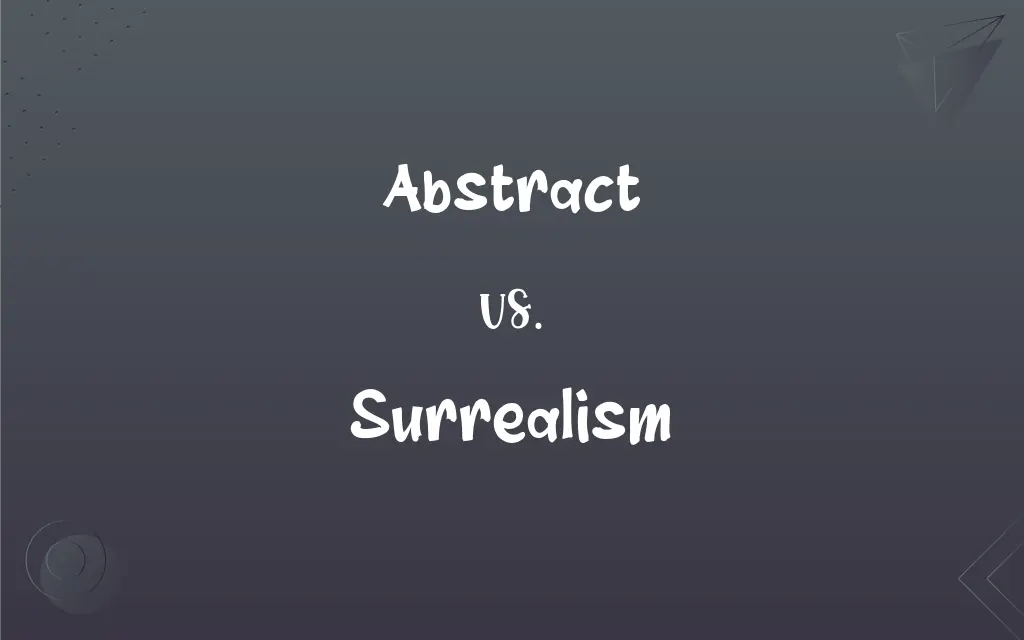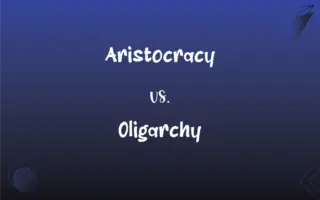Abstract vs. Surrealism: What's the Difference?
Edited by Janet White || By Aimie Carlson || Published on November 30, 2023
Abstract art uses shapes and colors to evoke emotions without depicting real forms, while Surrealism combines dreamlike, bizarre imagery to challenge reality.

Key Differences
Abstract art is characterized by its emphasis on visual elements like color, shape, and line, often disregarding real-world visual references. Surrealism, however, often uses realistic forms in illogical or dreamlike contexts to challenge perceptions of reality.
The purpose of abstract art is to evoke emotions and thoughts without depicting specific, recognizable objects or scenes. Surrealism seeks to explore the unconscious mind, bringing together bizarre and dream-like elements in a realistic style.
Abstract art does not attempt to represent an accurate depiction of visual reality but instead uses forms to create a composition which may exist with a degree of independence from the world. Surrealism, in contrast, often distorts reality in a way that is recognizable but irrational, bridging the gap between dream and reality.
Artists in abstract art focus on the power of colors and shapes to express their artistic vision. Surrealist artists blend the familiar with the strange, often tapping into themes of fantasy, the unconscious, and the irrational.
Abstract art is more about the expression and perception of emotions and ideas. Surrealism often tells a story, albeit a bizarre or illogical one, engaging viewers in a world of the subconscious mind.
ADVERTISEMENT
Comparison Chart
Visual Reference
Lacks real-world forms
Uses realistic forms in dreamlike contexts
Purpose
To evoke emotions without depicting specific scenes
To explore the unconscious mind with bizarre elements
Representation
Non-representational, focusing on forms
Distorts reality in a recognizable but irrational way
Artistic Focus
Colors and shapes to express vision
Blending the familiar with the strange
Narrative
Emphasis on emotion and perception
Often tells a surreal, dreamlike story
ADVERTISEMENT
Abstract and Surrealism Definitions
Abstract
Abstract is non-representational and does not depict specific objects or scenes.
The gallery's abstract collection challenged our perception of art.
Surrealism
Surrealism combines dreamlike, bizarre imagery with realistic elements.
His painting featured a clock melting over a tree, a classic surrealism piece.
Abstract
Abstract art uses forms, colors, and lines to create compositions independent of visual reality.
His painting was a swirl of colors, a perfect example of abstract art.
Surrealism
Surrealism blends the familiar with the strange and fantastical.
The surrealism painting showed a cityscape with bizarre, twisted buildings.
Abstract
Abstract art focuses on the power of pure form and color.
Her abstract canvases are celebrated for their vibrant use of color.
Surrealism
Surrealism distorts reality in a recognizable yet illogical way.
In her surrealism artwork, fish flew in the sky and people walked underwater.
Abstract
Abstract works exist with a level of independence from the world's visuals.
The abstract mural transformed the room into an emotional landscape.
Surrealism
Surrealism explores the unconscious mind and irrationality.
The surrealism exhibit was a deep dive into the artists' dreams and fears.
Abstract
Abstract emphasizes visual elements to convey emotions and ideas.
The abstract sculpture conveyed a sense of chaos through its twisted forms.
Surrealism
Surrealism often tells a story, engaging viewers in a subconscious world.
The surrealism film portrayed a journey through a landscape of the mind.
Abstract
Considered apart from concrete existence
An abstract concept.
Surrealism
A 20th century movement of artists and writers (developing out of Dadaism) who used fantastic images and incongruous juxtapositions in order to represent unconscious thoughts and dreams
Abstract
Not applied or practical; theoretical.
Surrealism
A literary and artistic movement of the 1900s that attempts to express the workings of the subconscious and is characterized by fantastic imagery and incongruous juxtaposition of subject matter.
Abstract
Difficult to understand; abstruse
Abstract philosophical problems.
Surrealism
Literature or art produced in this style.
Surrealism
An artistic movement and an aesthetic philosophy that aims for the liberation of the mind by emphasizing the critical and imaginative powers of the subconscious.
FAQs
How do you recognize abstract art?
Abstract art is recognized by its emphasis on visual elements like color, form, line, and texture, rather than depicting recognizable objects.
Is abstract art always non-representational?
Mostly, but some abstract art can include elements that hint at real-world forms.
Can abstract be used outside of art?
Yes, abstract can describe ideas or qualities not tied to physical objects or specific examples in various fields like philosophy, science, and mathematics.
What is surrealism?
Surrealism is an artistic and literary movement that sought to release the creative potential of the unconscious mind through strange, dream-like imagery.
What does "abstract" mean?
Abstract refers to art or concepts not representing external reality or concrete subjects but instead using shapes, colors, forms, and gestural marks to achieve its effect.
Is abstract art emotional?
Abstract art can evoke emotions through its use of color, form, and texture, often leaving interpretation up to the viewer.
Who are famous surrealists?
Salvador Dalí, René Magritte, and Joan Miró are among the most famous surrealists.
Can anything be abstract?
In a broad sense, yes. Ideas, concepts, and art can all be abstract if they don't directly represent tangible reality.
How is abstract art different from surrealism?
Abstract art doesn't represent real objects and focuses on elements like color and form, while surrealism portrays recognizable objects in dream-like, irrational settings.
Can an artwork be both abstract and surreal?
Yes, some artworks blend abstract elements with surreal imagery, although they are distinct movements.
When did surrealism begin?
Surrealism began in the early 1920s, following the Dada movement.
Can surrealism be found in literature?
Yes, surrealism significantly influenced literature, emphasizing unexpected juxtapositions and non-sequitur in writing.
Does surrealism use symbolism?
Yes, surrealism often uses symbolic imagery to convey deeper meanings or emotions.
Why do artists choose surrealism?
Artists choose surrealism to explore the unconscious mind, challenge conventional perceptions, and express imaginative ideas.
Can anyone create abstract or surreal art?
Yes, with creativity and an understanding of the principles, anyone can attempt abstract or surreal art.
How has technology impacted these art forms?
Technology has expanded the possibilities for both, allowing for digital abstract and surreal creations.
Is surrealism the same as abstract art?
No, surrealism often uses recognizable objects placed in unusual contexts, whereas abstract art does not typically represent real objects.
How have abstract and surrealism influenced modern art?
They have significantly influenced modern art by challenging traditional aesthetics and encouraging artistic innovation.
Are there famous abstract and surreal films?
Yes, films like "Un Chien Andalou" (Surrealism) and works by directors like Stan Brakhage (Abstract) are notable.
Do abstract and surreal art have specific techniques?
Both have varied techniques; abstract art often emphasizes expressive use of media, while surrealism may involve realistic techniques applied in fantastical ways.
About Author
Written by
Aimie CarlsonAimie Carlson, holding a master's degree in English literature, is a fervent English language enthusiast. She lends her writing talents to Difference Wiki, a prominent website that specializes in comparisons, offering readers insightful analyses that both captivate and inform.
Edited by
Janet WhiteJanet White has been an esteemed writer and blogger for Difference Wiki. Holding a Master's degree in Science and Medical Journalism from the prestigious Boston University, she has consistently demonstrated her expertise and passion for her field. When she's not immersed in her work, Janet relishes her time exercising, delving into a good book, and cherishing moments with friends and family.






































































